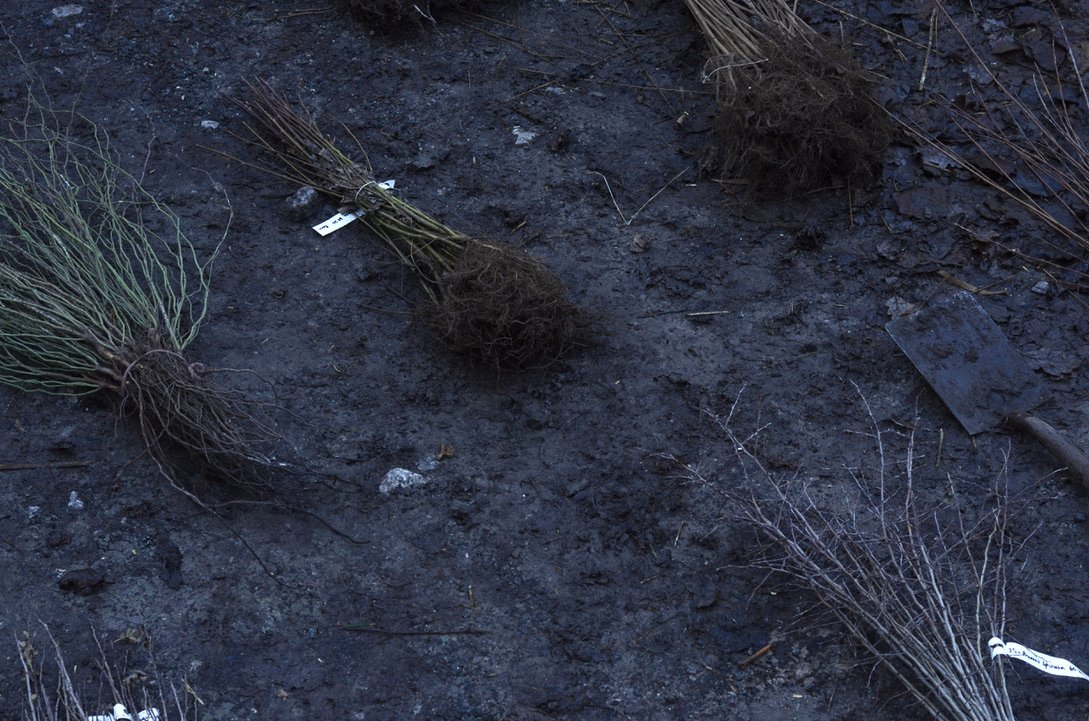the bank

A narrow track leads down to the house flanked either side by native trees and shrubs. Towering Ash and mature Hazels arch over to conceal the sky from sight. Once at the bottom of the track, the house and garden become visible in their entirety and with nothing to obscure it from view, the layered approach falls apart. An arrival to a garden is something to be celebrated, setting the tone and atmosphere to what lays ahead. In this case, it left nothing to the imagination. Yes, on one hand it was a welcomed sight, but on the other it left the car park exposed and allowed one’s eye to wander. We made the decision last spring that come winter we would plant up the bank that separated the brook from the car park, a modest sized planting area that would become a natural thicket comprised of natives. It would disguise the house on arrival leading you onto the bridge to reveal the first real glimpse into the garden, but equally as importantly, once over the bridge, it would screen the cars from view.
In the winter of 2020 we impulsively planted Salix purpurea along the water’s edge, knowing their vigour would soon provide a start to naturalising the bank. They joined the existing Corylus avellana, Alnus glutinosa, Prunus avium, Crataegus monogyna and Ilex aquifolium that were naturally established. When it came to choosing species that would join this mix we simply looked to what was thriving along the brook and in the surrounding woodland and hedgerows, a combination that would both suit the wetter ground closer to the brook and the higher slightly drier conditions.
David strimming the bank prior to planting.
This month, we set out to plant the bank. A combination of Corylus avellana, Crataegus monogyna, and Acer campestre will gradually occupy the brookside with an evergreen undercurrent of Ilex aquifolium that will provide structure in the winter, their habit relaxed as they intertwine between the neighbouring trees. The flat, perfumed flower heads of the Sambucus nigra will complement the Rosa canina, which has been added to provide impromptu romance with their ability to make an informal statement and Prunus spinosa will provide an early spring blossom. This winter we have been discussing the possibility of introducing Hamamelis onto the banks. Although not native, they would sit sympathetically and provide a beautiful show in winter, connecting to the solo Hamamelis within the garden. A question to ponder this year and act on next to enjoy its winter alliance.
A species seldom seen in the surrounding landscape is Frangula alnus. We have introduced this species into the wetter grounds surrounding the fringes of the brook. With subtle flowers appearing between May and June followed by red berries which ripen to purple-black in autumn, it’s leaves provide food for the caterpillars of the Brimstone Butterfly. It will be exciting to watch these establish and learn their language.
Cornus sanguinea has been positioned alongside the Frangula alnus, their shared conditions and informal habit celebrated as they take to naturalising the margin. Salix purpurea has also bene planted with their feet nearer to the waters edge, providing a grouping of shrubs that will soon be in conversation with the ever fluctuating brook.
Bare root planting needs to be undertaken in the winter months, the ground already wet and the plants dormant, a time where the terminal buds have already formed and the leaves have dropped, readying them to produce substantial root networks which will give them a head start before the spring. The majority of species were ordered as 60-80cm bare-root whips with the exception of a few 2L pots due to availability, sizes that give them a good start in life but will require 5/6 years before they begin to mature and fully screen the car park. Species such as Corylus and Crataegus (Quickthorn) will be faster to establish but in time the bank will reveal itself in flourishes with flowers, berries, nuts and scent to greet you on arrival.


